Coordinated Operation Strategy for Equitable Aggregation in Virtual Power Plant Clusters with Electric Heat Demand Response Considered
Abstract
1. Introduction
1.1. Background and Motivation
1.2. Literature Review
1.3. Contributions
- (1)
- It puts forward differentiated modeling of disparate types of VPPs and introduces an LA as the control center of the cluster. This greatly optimizes the efficiency of schedulable resource utilization within and sets up an internal sharing framework in the VPP cluster.
- (2)
- Acknowledging the influence of electricity prices on demand response, it integrates a flexible shared electricity pricing mechanism within the cluster and encourages all VPPs to publish their prices equitably. This stimulates VPP participation in collaborative scheduling, hence improving the economic operations of VPP clusters.
- (3)
- By recognizing that both the supply and demand sides possess Demand Response (DR) capabilities, the paper brings in a flexible dual response mechanism to further limit the operational costs of the VPP clusters.
2. Framework for VPP Clusters with Flexible Supply and Demand Response Mechanisms and Elastic Shared Electricity Pricing
2.1. Aggregation Unit
2.2. Load Type
- (1)
- Fixed Load: Both electric and thermal loads of fixed nature do not participate in DR.
- (2)
- Movable Load: The users can choose different methods of energy supply to meet their needs in the same time period, with examples from day-to-day life instances being as follows: 1. For domestic hot water needs, users can opt for thermal power supplied by the heat pipeline, or they might choose electric or gas water heaters; 2. for heating needs, users can choose thermal power from the heat pipeline or opt for electric air conditioning; 3. for cooking needs, users have the choice of using induction stoves or gas stoves, etc. The DR of movable loads does not alter the user’s energy needs and thus does not impact them.
- (3)
- Reducible Load: Loads able to withstand certain disruptions, power reduction, and reduced operation time, and they can be partially or wholly reduced depending on the supply-demand circumstances. The power supply time for these loads can be pragmatically adjusted, the loads need to be entirely shifted, and the electricity usage time spans multiple scheduling periods.
2.3. Flexible Shared Electricity Pricing Mechanism
3. VPP Cluster Model Driven by Flexible Shared Electricity Pricing
3.1. Flexible Shared Electricity Pricing Model
3.2. Flexible Dual Response Model for Supply and Demand
- (1)
- Constraint relation between the electric power output of the gas turbine and the gas consumption:
- (2)
- Constraints between the electricity consumption of the gas boiler and ground-source heat pump and their respective heat power outputs:
- (3)
- Constraints on Energy Storage Charging and Discharging
- (4)
- Response to Electric and Thermal Load Requirements
- (5)
- Electric and Thermal Power Balance Constraints
3.3. Objective Function
4. Case Simulation
- Scenario 1 (S1) operates under grid electricity purchase and sales pricing without the intervention of heat and electricity supply-demand responses;
- Scenario 2 (S2) involves a sharing of electricity pricing within the cluster, disregarding supply and demand-side heat and electricity responses;
- Scenario 3 (S3) discards in-cluster shared electricity pricing but includes heat and electricity supply-demand response mechanisms;
- Scenario 4 (S4) is inclusive of both internal cluster shared electricity pricing and heat and electricity supply-demand responses.
4.1. Fundamental Data
- (1)
- Electricity Load Forecast for Each VPP
- (2)
- Prediction of DRE Output Within Each VPP
- (3)
- Prediction of Heat Loads Within Each VPP
4.2. Analysis of Shared Electricity Pricing and Optimization of Operating Cost Results
4.3. Optimization Outcomes for Electrical Load of Each VPP
- (1)
- Optimization Results of Electricity Load Supply for Each VPP
- (2)
- Optimization Results of Electricity Load Response Strategy for Each VPP
4.4. Optimization Outcomes for Heat Load of Each VPP
- (1)
- Optimization Results of Heat Load Supply for Each VPP
- (2)
- Optimized Results of the Heat Load Response Strategy for Each VPP
5. Conclusions
- (1)
- The study introduces a flexible shared electricity price mechanism, superseding the conventional timeslot fixed electricity prices. By adjusting intermediate electricity prices through carbon emission indicators, an internal flexible shared electricity price that takes into account carbon emissions is devised. This incentivizes and guides each VPP to participate in regulation, effectively slashing the operation costs and carbon emissions of the cluster, thus facilitating a more carbon-conscious operation.
- (2)
- Under the flexible shared electricity pricing mechanism, a response strategy for supply side appliances is established. By flexibly managing the output of various electrical and heat generation units, the utilization efficiency improves within the VPP cluster, and the dependence on external power grids decreases. As such, the VPP cluster lessens its impact on the power grid, mitigates grid fluctuations, minimizes the dependency on the grid, and enhances system independence.
- (3)
- In regard to conducting demand-side responses for the electrical and thermal loads within the cluster, aiming to reduce and shift loads for the purpose of minimal operating costs, through effective energy optimization scheduling, it is noticeable that operation costs of the VPP can be significantly reduced, thereby making way for increased consumption of renewable energy.
- (1)
- Extensive applications and verification: Expand the research to various geographical and climatic conditions, analyzing how these elements influence the operational efficiency and economic aspect of VPPs. Carry out pilot projects in multiple regions, gather data from actual operations, and validate the universality of the model as well as the effectiveness of the adjustment tactics.
- (2)
- Technological and algorithmic innovation: Investigate the utilization of AI and ma-chine learning technologies in VPP management, particularly in terms of load forecasting and energy dispatch optimization. By the introduction of sophisticated algorithms, boost the system’s response speed and the precision of decision-making.
- (3)
- Policy mechanism research: Examine the effects of various market policies and incentive measures on VPP operation. Thoroughly analyze the long-term influences of policy changes on the energy market, propose adaptable operational strategies, and deal with the uncertainties of the market and policies.
- (4)
- Environmental impact assessment: From a sustainability and environmental conservation perspective, evaluate the environmental impacts of VPP operations. Study ways to reduce carbon emissions by optimizing dispatch strategies, supporting the achievement of global carbon reduction goals.
- (5)
- System Integration: Investigate the integration potential of VPPs with other energy systems like smart buildings and electric vehicle charging networks. By implementing cross-system collaboration, energy can be used and managed more efficiently, leading to an enhanced flexibility and resilience of the overall energy system.
Author Contributions
Funding
Data Availability Statement
Conflicts of Interest
Appendix A
| Equipment | Electrical Output Constraints/kW | Thermal Output Constraints/kW |
|---|---|---|
| Gas turbine | 0–1000 | 0–1877 |
| Gas boiler | / | 0–1000 |
| Heat pump | / | 0–600 |
| Equipment | /kWh | /kW | /kWh | /kWh | /kWh | |
|---|---|---|---|---|---|---|
| Battery | 500 | 200 | 250 | 50 | 450 | 0.90 |
| Parameters | Numerical Values |
|---|---|
| 0.88 | |
| 0.58 | |
| 1.2 | |
| 0.34 | |
| 0.4 | |
| 0.92 | |
| 4.5 | |
| 0.15 | |
| 0.15 |
References
- Jia, X.; Zhang, Y.; Tan, R.R.; Li, Z.; Wang, S.; Wang, F.; Fang, K. Impact of renewable energy penetration rate on power system frequency stability. Energy Rep. 2022, 8, 997–1003. [Google Scholar]
- Jia, X.; Zhang, Y.; Tan, R.R.; Li, Z.; Wang, S.; Wang, F.; Fang, K. Multi-objective energy planning for China’s dual carbon goals. Sustain. Prod. Consum. 2022, 34, 552–564. [Google Scholar] [CrossRef]
- Mishra, S.; Bordin, C.; Leinakse, M.; Wen, F.; Howlett, R.J.; Palu, I. Virtual Power Plants and Integrated Energy System: Current Status and Future Prospects. In Handbook of Smart Energy Systems; Springer: Berlin/Heidelberg, Germany, 2023; pp. 115–145. [Google Scholar]
- Hadayeghparast, S.; Farsangi, A.S.N.; Shayanfar, H. Day-ahead stochastic multi-objective economic/emission operational scheduling of a large scale virtual power plant. Energy 2019, 172, 630–646. [Google Scholar] [CrossRef]
- Akkaş, Ö.P.; Çam, E. Optimal operational scheduling of a virtual power plant participating in day-ahead market with consideration of emission and battery degradation cost. Int. Trans. Electr. Energy Syst. 2020, 30, e12418. [Google Scholar] [CrossRef]
- Zamani, A.G.; Zakariazadeh, A.; Jadid, S.; Kazemi, A. Stochastic operational scheduling of distributed energy resources in a large scale virtual power plant. Int. J. Electr. Power Energy Syst. 2016, 82, 608–620. [Google Scholar] [CrossRef]
- Hannan, M.A.; Abdolrasol, M.G.M.; Mohamed, R.; Al-Shetwi, A.Q.; Ker, P.J.; Begum, R.A.; Muttaqi, K.M. ANN-Based Binary Backtracking Search Algorithm for VPP Optimal Scheduling and Cost-Effective Evaluation. IEEE Trans. Ind. Appl. 2021, 57, 5603–5613. [Google Scholar] [CrossRef]
- Liu, W.; Gu, W.; Sheng, W.; Song, X.; Gao, F. Virtual cluster control for active distribution system using Pinning-based distributed secondary control. Int. J. Electr. Power Energy Syst. 2019, 109, 710–718. [Google Scholar] [CrossRef]
- Wille-Haussmann, B.; Erge, T.; Wittwer, C. Decentralised optimisation of cogeneration in virtual power plants. Sol. Energy 2010, 84, 604–611. [Google Scholar] [CrossRef]
- Wang, J.; Du, W.; Yang, D.; Liu, G.; Chen, H. An optimal scheduling method of virtual power plant cluster considering generation-grid-load-storage coordination. In Proceedings of the 2021 6th Asia Conference on Power and Electrical Engineering (ACPEE), Chongqing, China, 8–11 April 2021; IEEE: Piscataway, NJ, USA, 2021; pp. 1048–1052. [Google Scholar]
- Li, X.; Zhao, D.; Guo, B. Decentralized and collaborative scheduling approach for active distribution network with multiple virtual power plants. Energies 2018, 11, 3208. [Google Scholar] [CrossRef]
- Gong, T.; Chen, S.; Shi, K.; Chai, Z.; Wang, Y. Internal revenue sharing methodology for virtual power plant clusters considering carbon incentive and penalty mechanisms. J. Comput. Methods Sci. Eng. 2024, 24, 51–68. [Google Scholar] [CrossRef]
- Zuo, J.; Xu, C.; Wang, W.; Ji, Y. Distributionally robust optimization for virtual power plant clusters considering carbon emission-based dynamic dispatch priority. Front. Energy Res. 2023, 11, 1214263. [Google Scholar] [CrossRef]
- Lee, D.; Cheng, C.C. Energy savings by energy management systems: A review. Renew. Sustain. Energy Rev. 2016, 56, 760–777. [Google Scholar] [CrossRef]
- Jia, Y.; Mi, Z.; Yu, Y.; Song, Z.; Sun, C. A bilevel model for optimal bidding and offering of flexible load aggregator in day-ahead energy and reserve markets. IEEE Access 2018, 6, 67799–67808. [Google Scholar] [CrossRef]
- Li, N.; Tan, C.; Lin, H.; Ma, X.; Zhang, X. Three-level interactive energy management strategy for optimal operation of multiple virtual power plants considering different time scales. Int. J. Energy Res. 2021, 45, 1069–1096. [Google Scholar] [CrossRef]
- Chu, T.; Wang, T.; Li, M.; Feng, J.; Sun, Y.; Liu, X. Research on the collaborative management of internal and external fluctuations and optimization of power trading in multi-virtual power plants. Front. Energy Res. 2024, 11, 1337205. [Google Scholar] [CrossRef]
- Gao, H.; Zhang, F.; Xiang, Y.; Ye, S.; Liu, X.; Liu, J. Bounded rationality based multi-VPP trading in local energy markets: A dynamic game approach with different trading targets. CSEE J. Power Energy Syst. 2021, 9, 221–234. [Google Scholar]
- Pandey, A.K.; Jadoun, V.K.; Sabhahit, J.N. Real-time peak valley pricing based multi-objective optimal scheduling of a virtual power plant considering renewable resources. Energies 2022, 15, 5970. [Google Scholar] [CrossRef]
- Zhou, B.R.; Liu, S.L.; Zhang, Y.J.; Yi, Y.Q.; Lin, X.M. Multi-objective optimal power flow for active distribution network considering the stochastic characteristic of photovoltaic. In IOP Conference Series: Earth and Environmental Science; IOP Publishing: Bristol, UK, 2017; Volume 67. [Google Scholar]
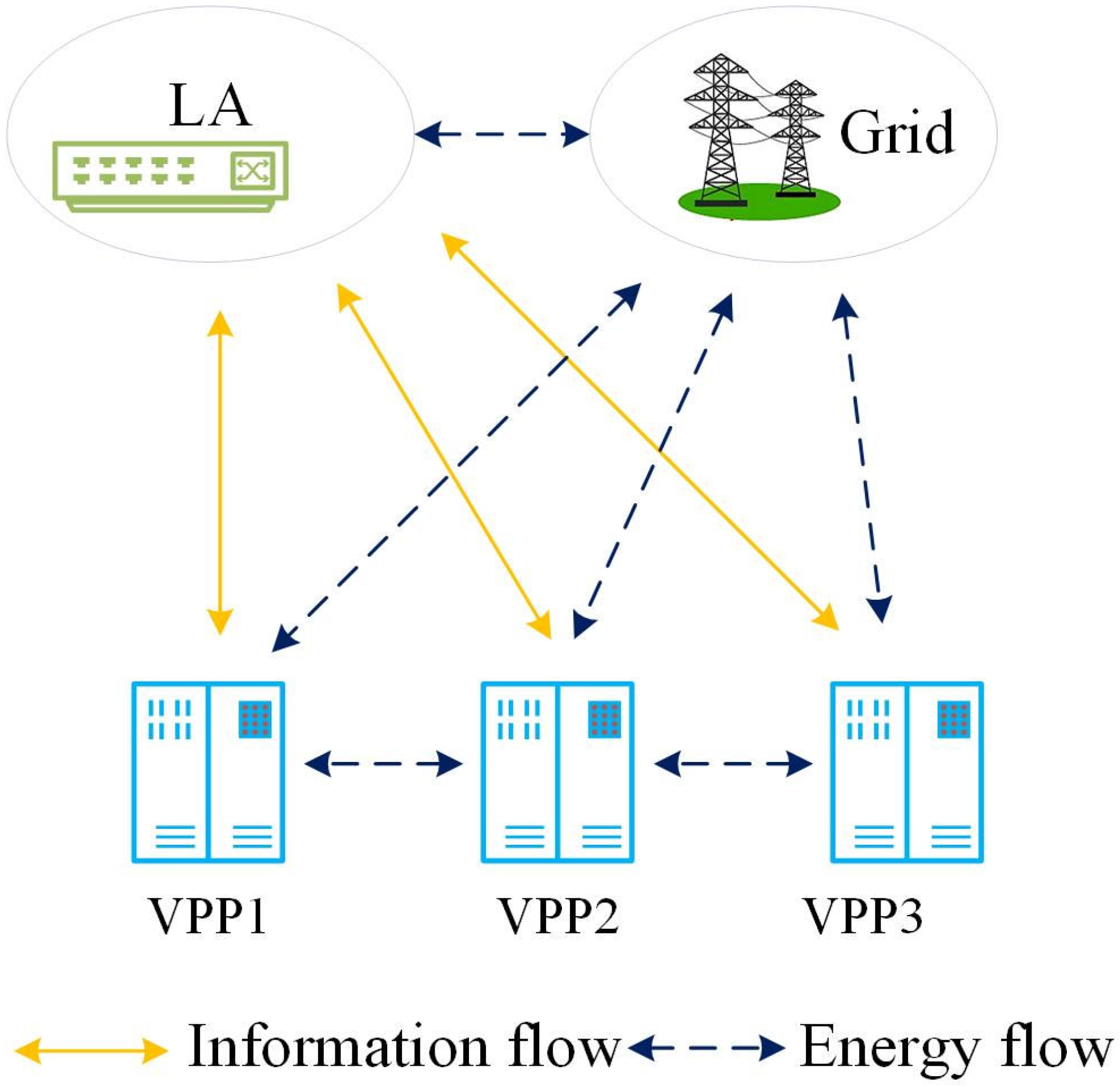
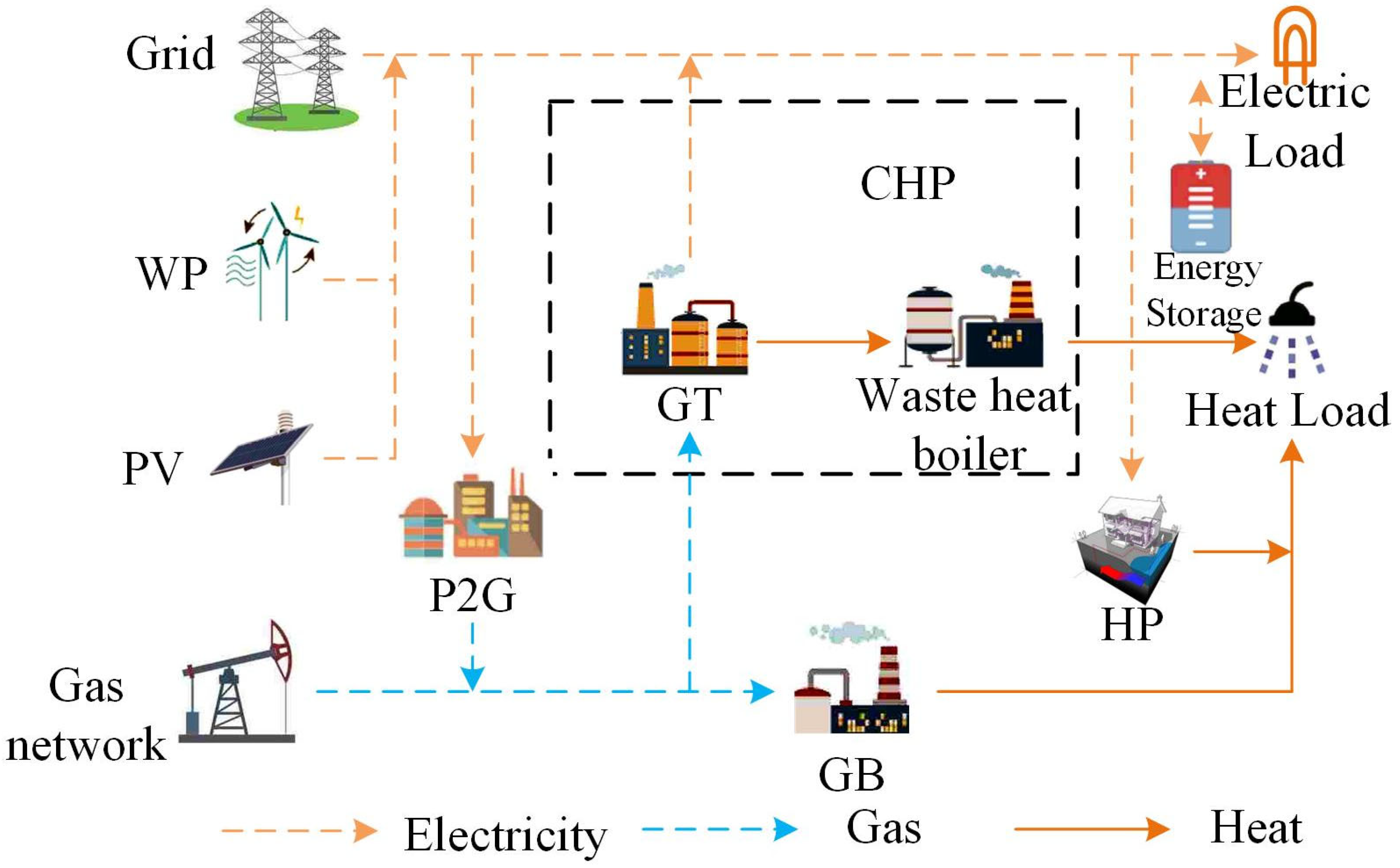
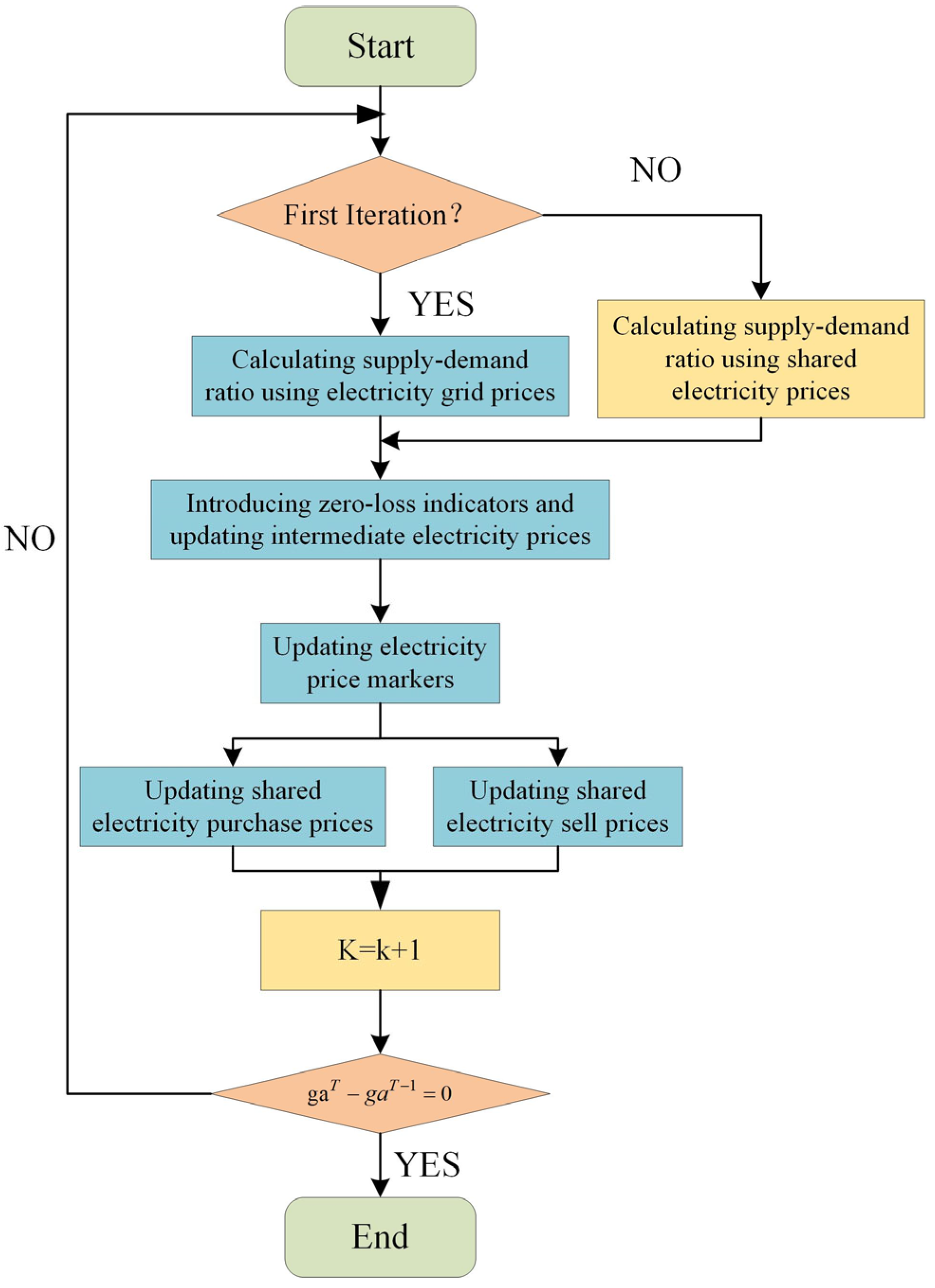
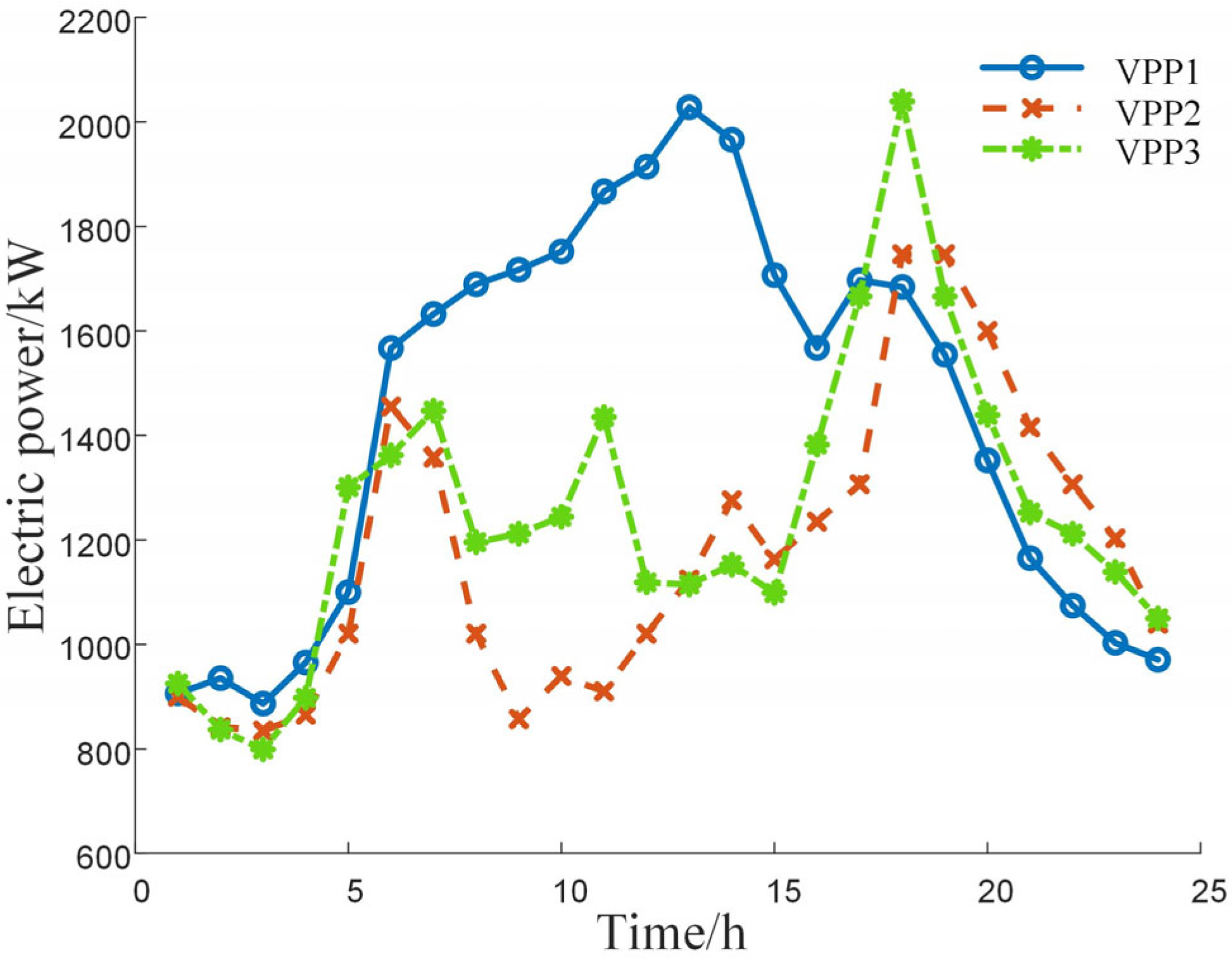
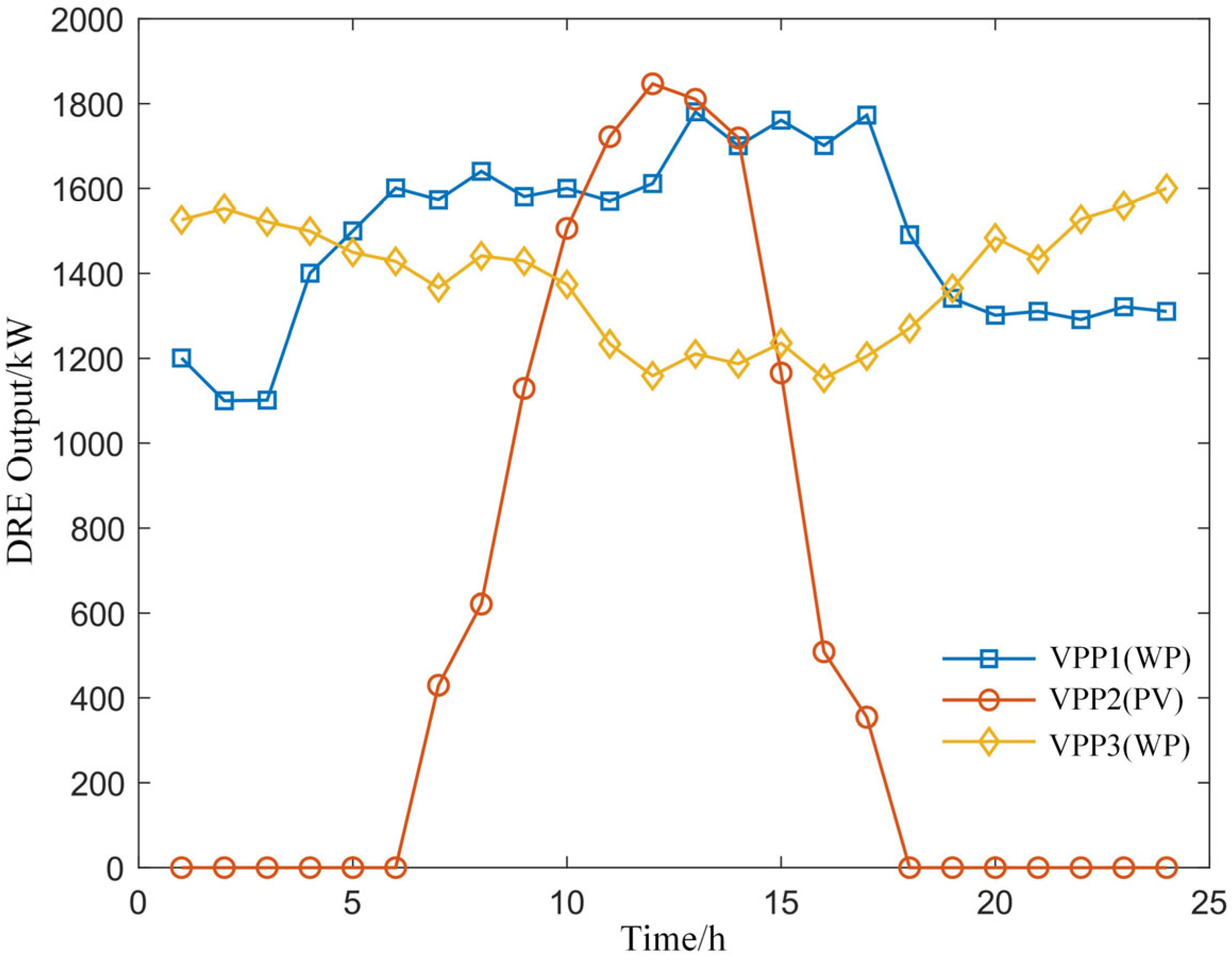
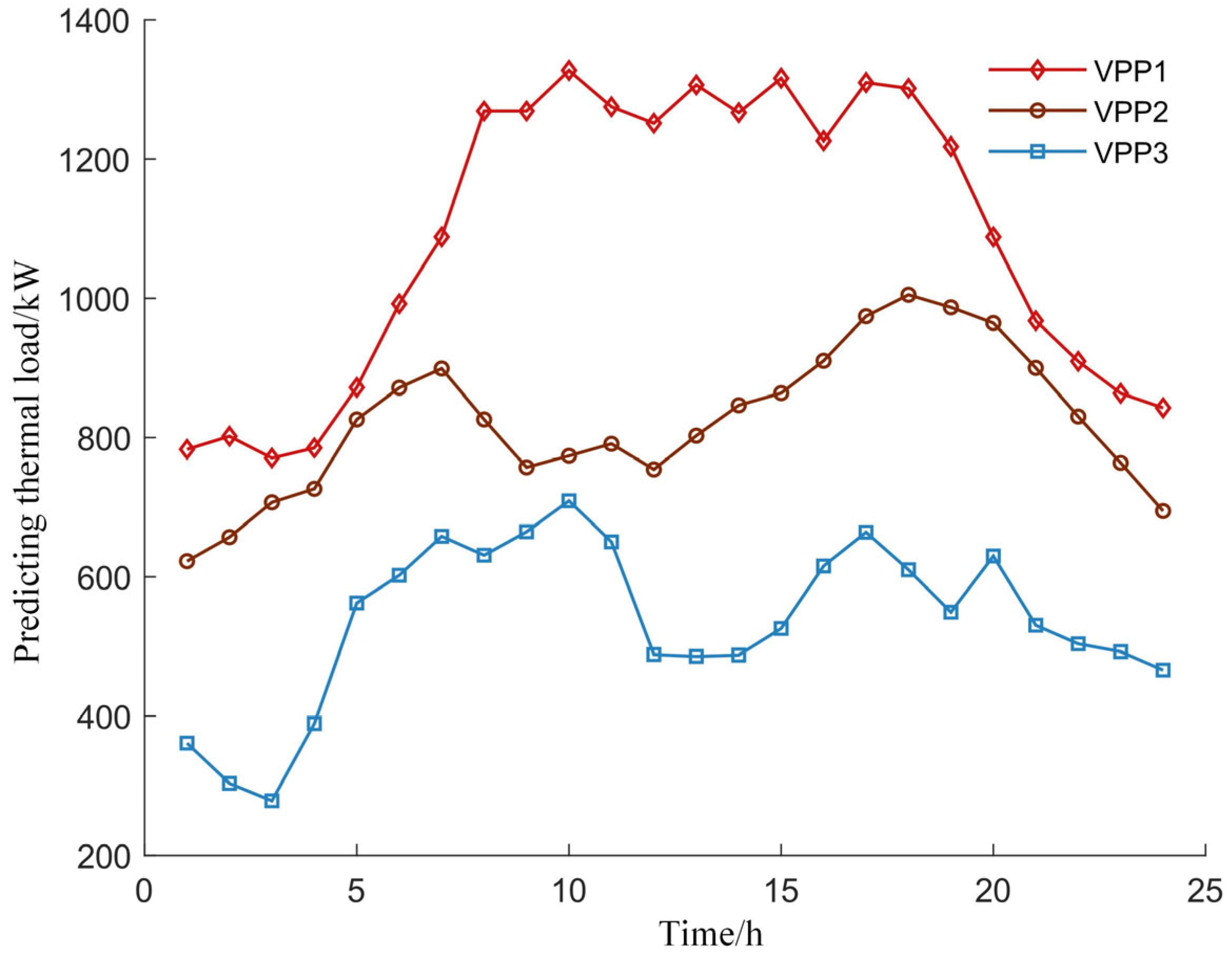
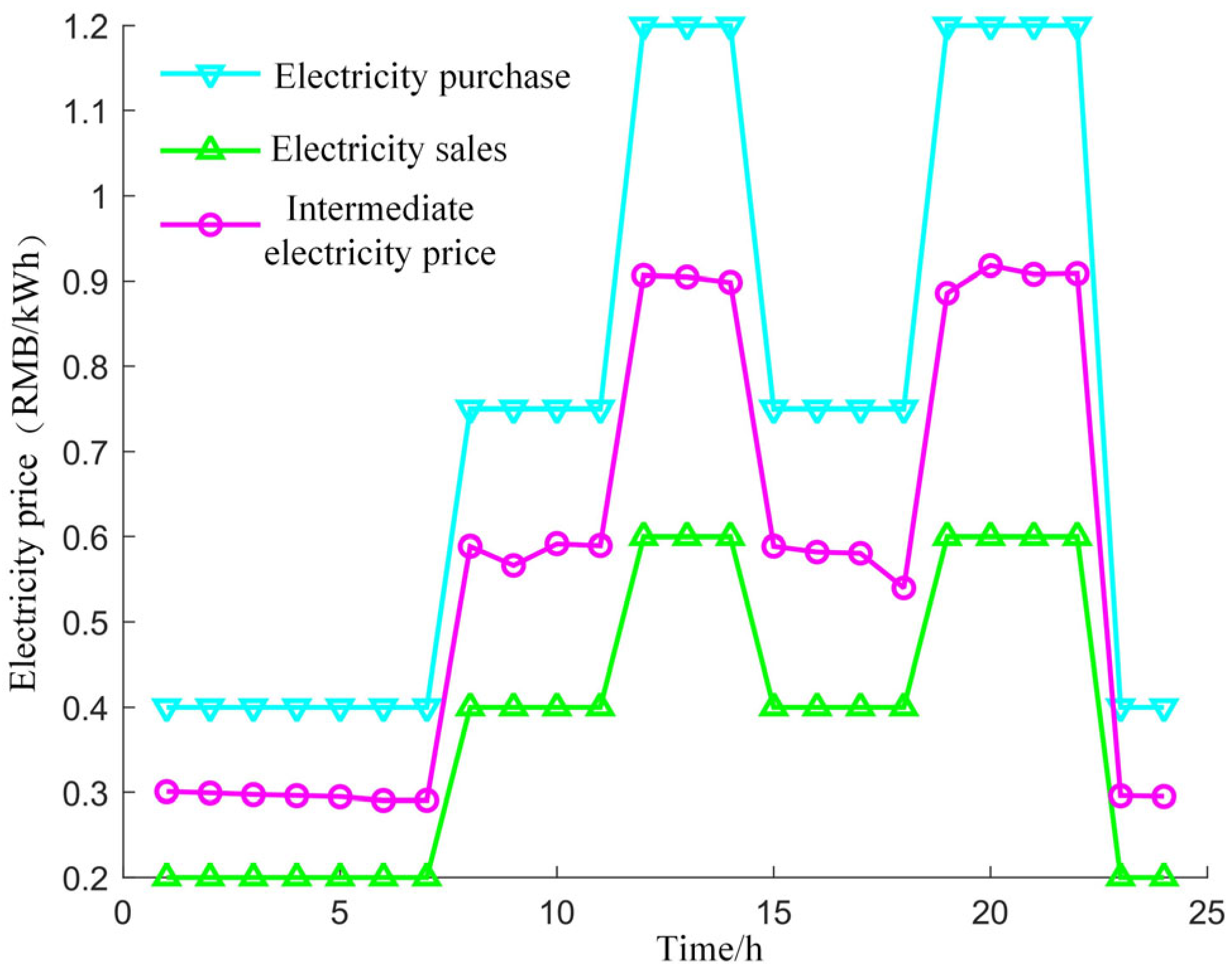
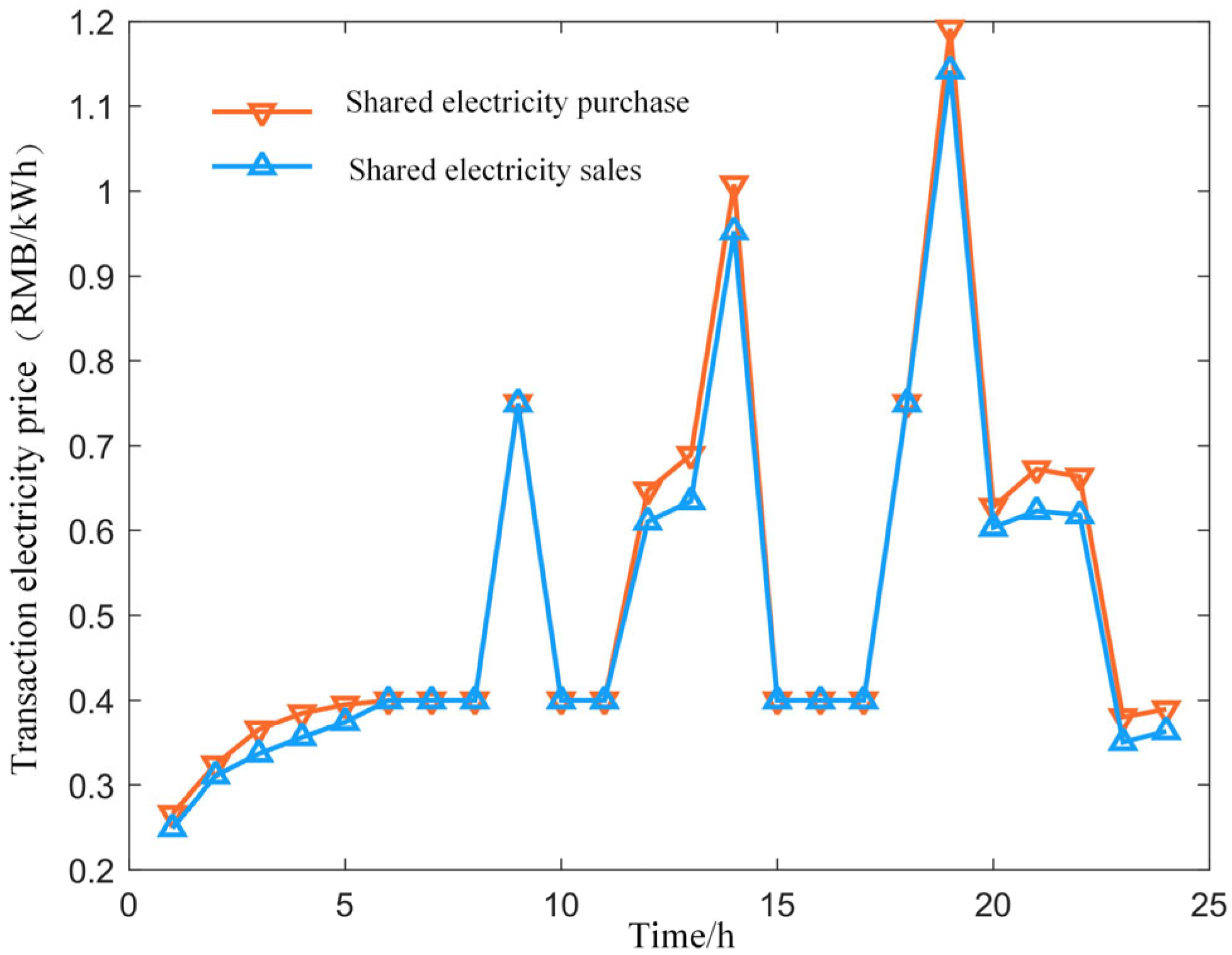
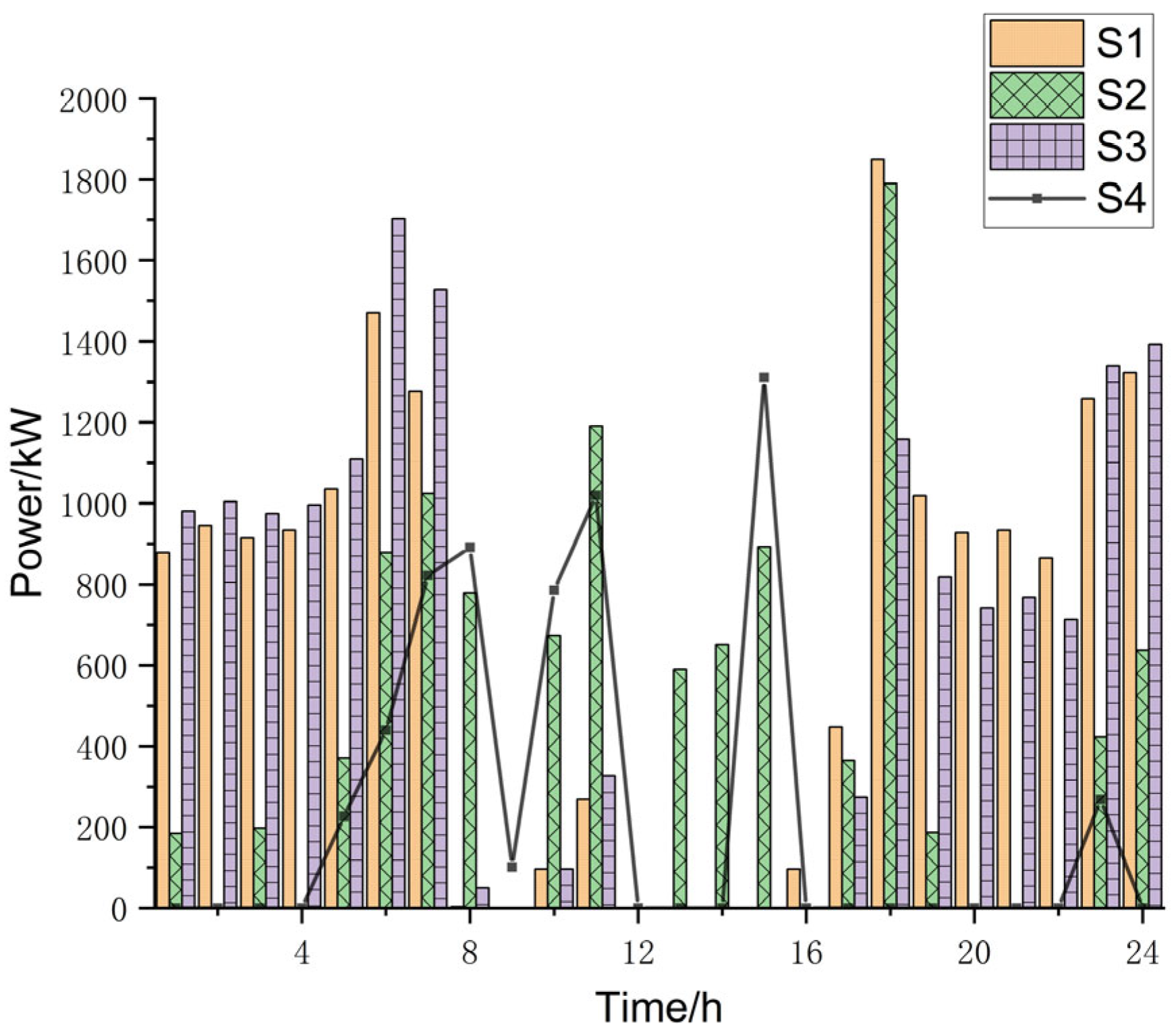
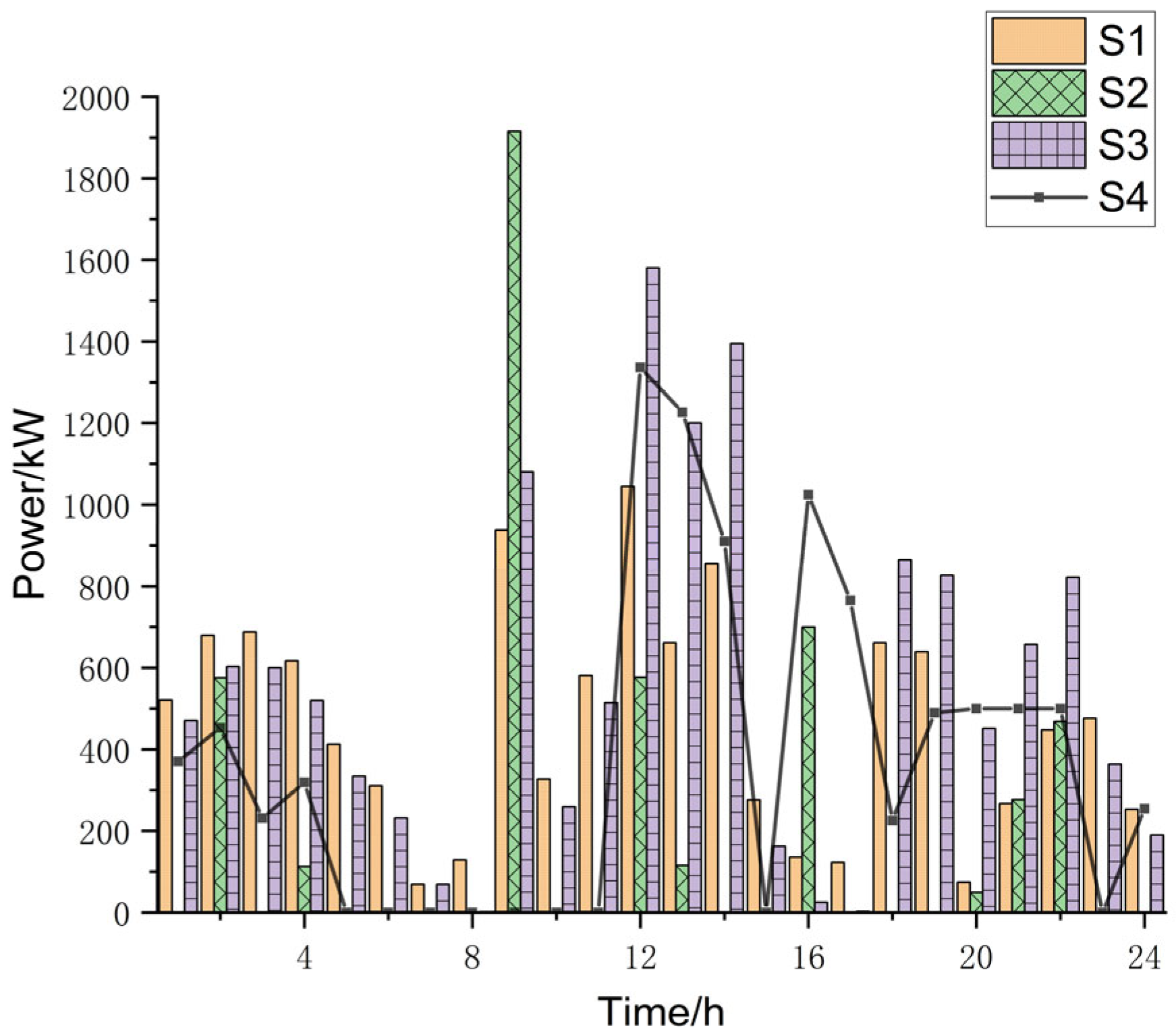
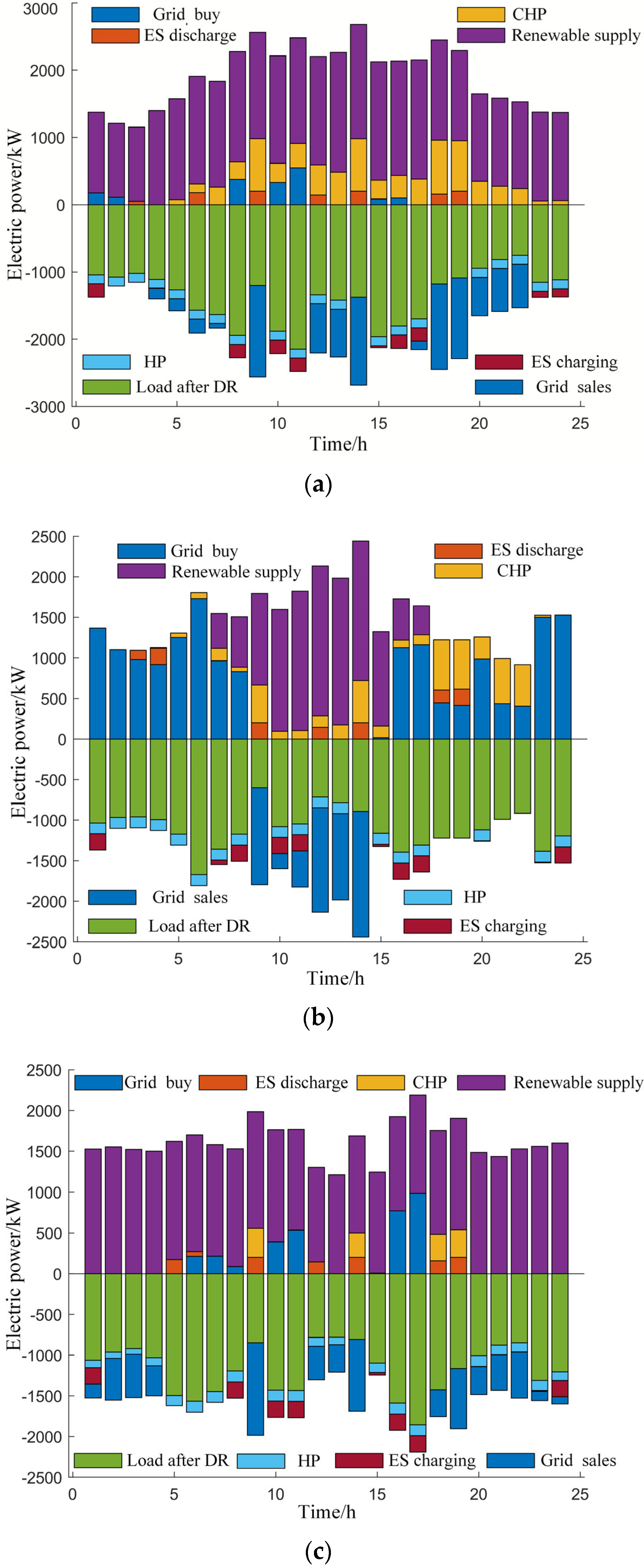
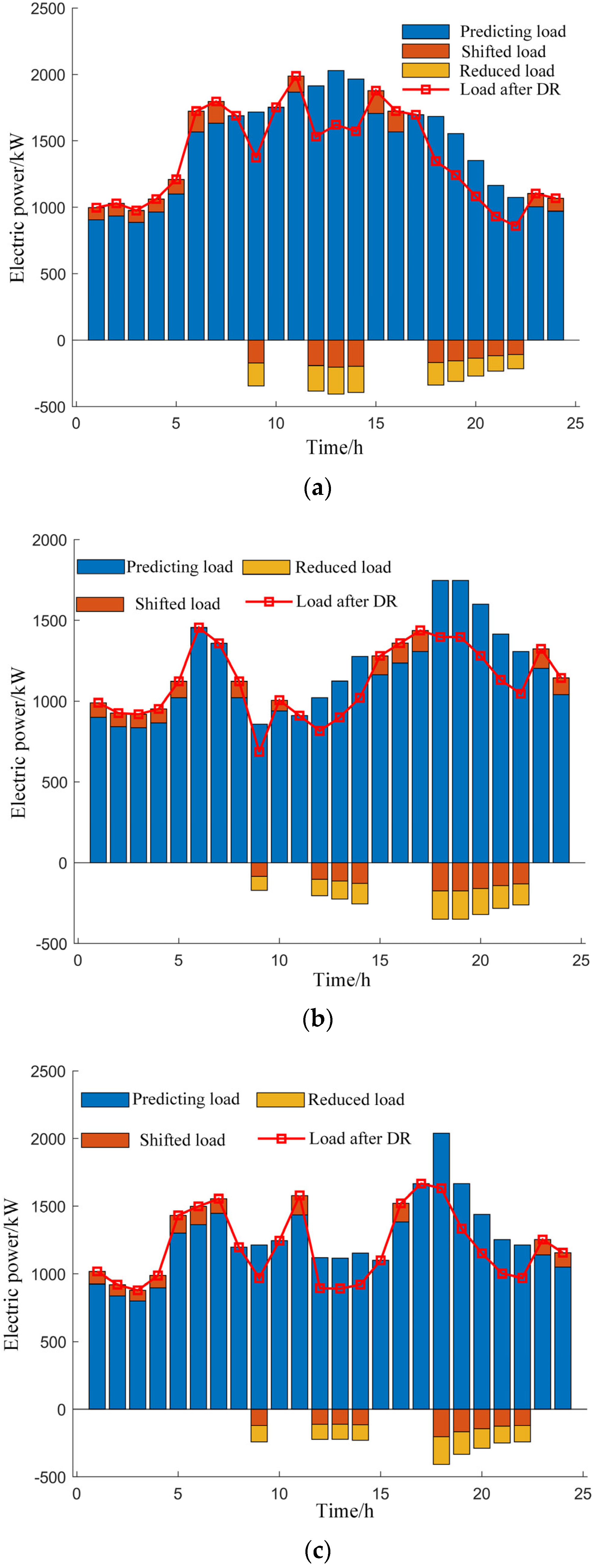
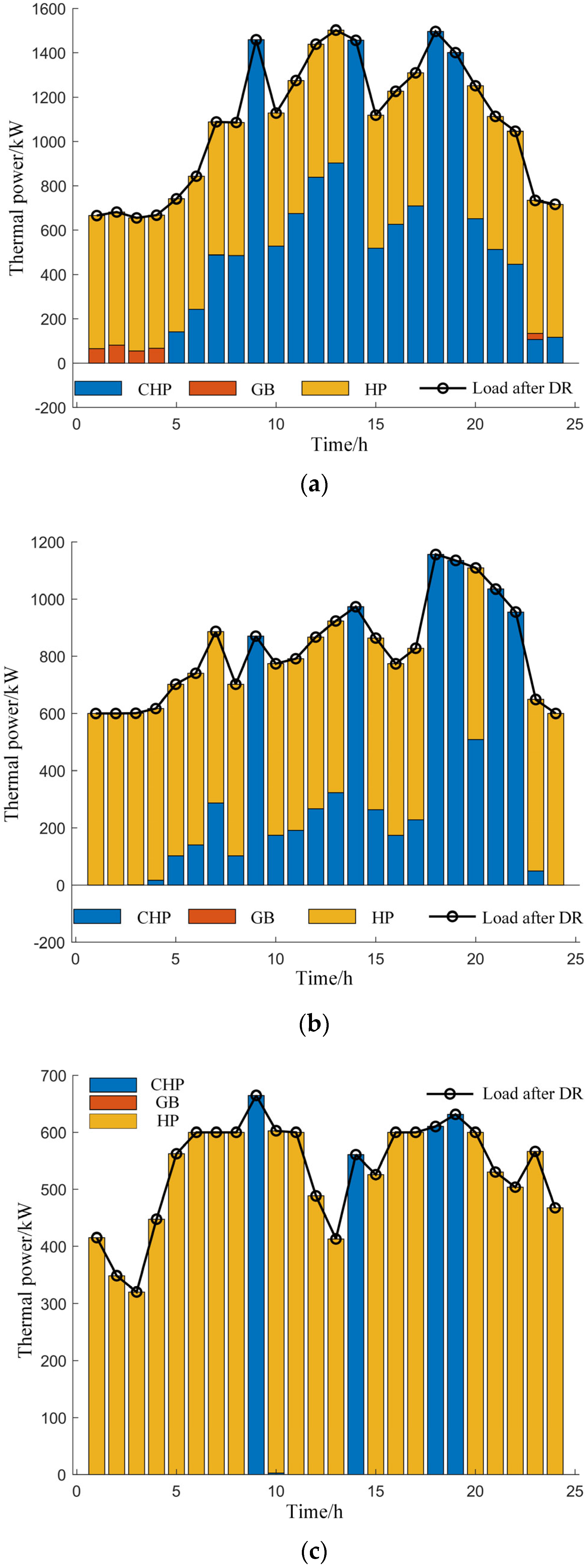
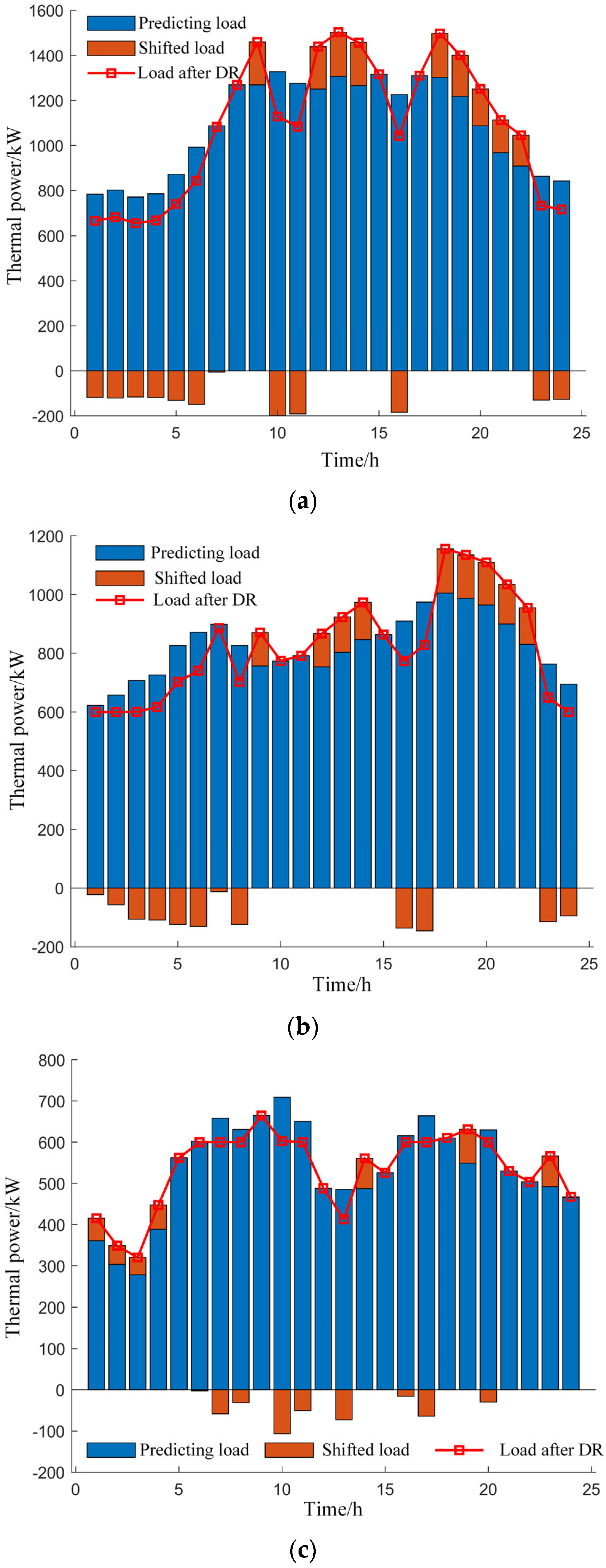
| VPP Optimization Model | Energy Cooperation Methods | |||||
|---|---|---|---|---|---|---|
| Carbon Emission | Cluster Control | Demand Response | Flexible Dual Response to Supply and Demand | Internal Electricity Price | LA Comprehensive Control | |
| References [4,5] | √ | |||||
| Reference [6] | √ | |||||
| Reference [7] | √ | |||||
| References [8,9,10,11,12,13] | √ | |||||
| Reference [15] | √ | √ | ||||
| References [16,17,18] | √ | √ | ||||
| Reference [19] | √ | √ | √ | |||
| This paper | √ | √ | √ | √ | √ | √ |
| Operating Cost | Electricity Purchased/kW | Electricity Sold/kW | Carbon Emissions/kg | ||||
|---|---|---|---|---|---|---|---|
| VPP1/RMB | VPP2/RMB | VPP3/RMB | Total Cost/RMB | ||||
| S1 | 3490.2 | 13,256.5 | 1198.4 | 17,945.1 | 16,538.8 | 11,186.1 | 60,918.1 |
| S2 | 4556.8 | 11,199.7 | 503.0 | 16,260.0 | 8801.5 | 4788.6 | 60,694.7 |
| S3 | 3034.6 | 12,584.8 | 678.7 | 16,298.1 | 15,967.5 | 13,222.8 | 58,958.9 |
| S4 | 4095.6 | 11,452.9 | 304.4 | 15,853.0 | 5862.0 | 9107.2 | 57,694.2 |
Disclaimer/Publisher’s Note: The statements, opinions and data contained in all publications are solely those of the individual author(s) and contributor(s) and not of MDPI and/or the editor(s). MDPI and/or the editor(s) disclaim responsibility for any injury to people or property resulting from any ideas, methods, instructions or products referred to in the content. |
© 2024 by the authors. Licensee MDPI, Basel, Switzerland. This article is an open access article distributed under the terms and conditions of the Creative Commons Attribution (CC BY) license (https://creativecommons.org/licenses/by/4.0/).
Share and Cite
Liu, Z.; Zhu, R.; Kong, D.; Guo, H. Coordinated Operation Strategy for Equitable Aggregation in Virtual Power Plant Clusters with Electric Heat Demand Response Considered. Energies 2024, 17, 2640. https://doi.org/10.3390/en17112640
Liu Z, Zhu R, Kong D, Guo H. Coordinated Operation Strategy for Equitable Aggregation in Virtual Power Plant Clusters with Electric Heat Demand Response Considered. Energies. 2024; 17(11):2640. https://doi.org/10.3390/en17112640
Chicago/Turabian StyleLiu, Zixuan, Ruijin Zhu, Dewen Kong, and Hao Guo. 2024. "Coordinated Operation Strategy for Equitable Aggregation in Virtual Power Plant Clusters with Electric Heat Demand Response Considered" Energies 17, no. 11: 2640. https://doi.org/10.3390/en17112640
APA StyleLiu, Z., Zhu, R., Kong, D., & Guo, H. (2024). Coordinated Operation Strategy for Equitable Aggregation in Virtual Power Plant Clusters with Electric Heat Demand Response Considered. Energies, 17(11), 2640. https://doi.org/10.3390/en17112640





